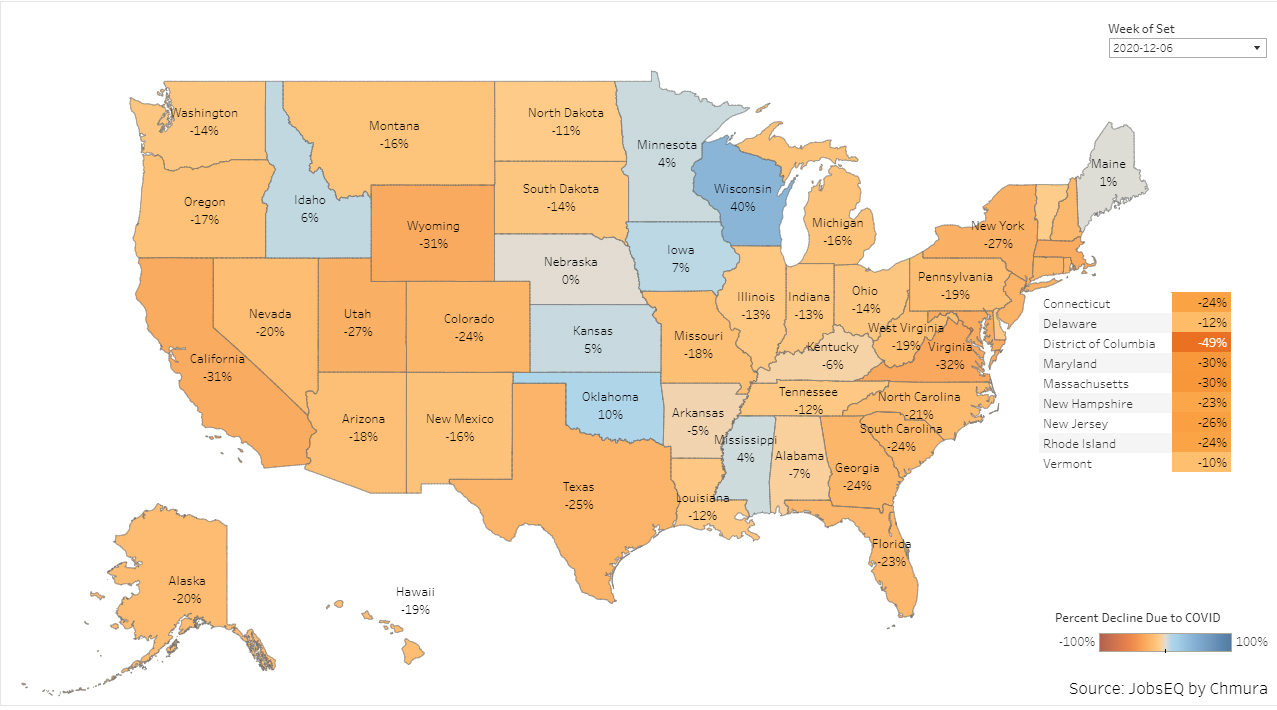RTI State Recovery Model

By James Stinchcomb |
Using the full RTI dataset, Chmura has developed a model to predict what new RTI volume would be for each week of 2020 under a scenario where the COVID-19 pandemic had never occurred – what we call "expected volume." By comparing observed volume to expected volume, we can better understand how much volume changes are directly related to the pandemic and recovery, allowing us to better track the recovery.
To help visitors better track the recovery in their own state, Chmura is making our expected volume data available through the two interactive graphics below. The first is a map that displays the percentage difference between expected volume and observed volume for every state on a specified week, with every week of the pandemic (week of March 1 through latest available data) being viewable. This allows you to easily compare the recovery in your state to other states in the nation. The second chart is a time series graph, plotting expected volume and observed volume for a specified state (or the United States) allowing you to track the recovery over time. Hover over either line in the chart to see the indexed expected volume, indexed observed volume, and the percentage difference between the two. Select a state on the map to see that state's time series chart or deselect all states to see the U.S. chart.
FAQ
1. Why does the expected volume model show such a large gap between current job postings volume and expected volume while JobsEQ RTI raw job ads data shows current volume is nearly caught up to the volume from the prior year?
The main difference between the two comparisons is that the expected volume model is accounting for expected growth in volume had the pandemic not occurred. Because volume is expected to grow year-over-year, the expected volume comparison will show a larger gap than when comparing to volume from one year ago. For example, during the four weeks of February 2, 2020 through February 29, 2020, immediately prior to the pandemic impacting job postings, average national weekly RTI volume was 15% higher than one year prior. This growth is reflected in the expected volume model.
2. So which comparison should be used?
Both! Each comparison provides value for measuring the recovery and trying to understand the current state of the economy. Comparing to volume from one year prior is a way of measuring how far away we are from getting back to the way things were, getting back to normal. On the other hand, comparing volume to the expected volume can help measure "potential;" for example, a region that was growing rapidly before the pandemic is likely to have a higher potential for growth during the recovery, meaning the region may reach previous levels of volume sooner than another region, despite potentially still being below expected volume.
Having said all of this, with the country approaching the 1-year anniversary of the onset of the pandemic and its impact on the economy, the value and interpretation of each measure is changing and will need to be reconsidered. The expected volume model, using pre-pandemic growth as a primary variable, will hold less informative value the farther away we move from the initial comparison point. At the same time, comparing volume to one year prior will lose a lot of value once we are comparing to pandemic levels, especially when comparing to early on in the pandemic's impact. Comparing to late March through April 2020, for example, is likely to be very troublesome and not hold a lot of comparative value as we will be comparing to the point when the pandemic was having its largest impact and many initial shutdown orders were going into effect. During this time, current volume will almost certainly exceed prior volume, and likely significantly, however that will not tell us much about the current recovery since the driving factor of the volume difference will be what had happened a year ago.
To account for these issues, we will be working on an update to the expected volume model to blend the two comparisons, accounting for growth but also adjusting for the shift caused by the pandemic. In other words, the model will attempt to measure expected volume under the "new normal."
About the Model
To learn more about the expected volume model, please read these two blogs:
COVID-19: RTI Recovery Update and Introducing State Level Recovery Tracking
COVID-19: Measuring the Impact on Job Postings During the Pandemic
Subscribe to the Weekly Economic Update
Subscribe to the Weekly Economic Update and get news delivered straight to your inbox.










